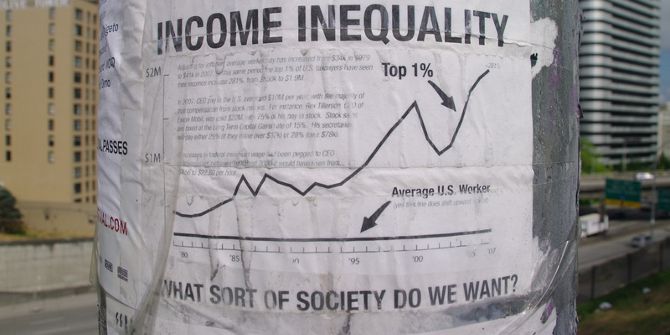 Like the US, Canada has experienced pronounced growth in earnings inequality over the past three decades. But what is less well known is how this inequality differs between regions. In new research, Sébastien Breau finds that inequality is higher in the western provinces compared to the eastern ones, and between urban and rural regions. He writes that these geographical differences in inequality are linked to a region’s industrial composition, local demographics, and the decline in unionization rates and cutbacks to government welfare programs.
Like the US, Canada has experienced pronounced growth in earnings inequality over the past three decades. But what is less well known is how this inequality differs between regions. In new research, Sébastien Breau finds that inequality is higher in the western provinces compared to the eastern ones, and between urban and rural regions. He writes that these geographical differences in inequality are linked to a region’s industrial composition, local demographics, and the decline in unionization rates and cutbacks to government welfare programs.
Since the Occupy movement mobilized the attention of the public back in the fall of 2011, the topic of earnings inequality has sparked much discussion and debate in academic and policy circles. It is now well known that over the last 30 years earnings inequality has been increasing in Canada. Driven in large part by the growing concentration of incomes at the top end of the distribution, this increase in inequality was particularly pronounced from the early 1990s to the mid-2000s, a period when it grew in Canada at a faster and more sustained pace than in the US.
Despite a growing body of literature documenting this trend at the national-level, much less is known about changes in the geography of earnings inequality across the Canadian landscape and about how differences in place-based characteristics may influence regional trajectories of inequality. New research using micro-data files from the 20 percent long-form sample of the Canadian Census of Population suggests that significant regional divides are indeed emerging.
Figure 1 maps out values of the Gini coefficient across Canadian census divisions (i.e., these are similar to counties in the US). The Gini coefficient is a well-known summary index of inequality with values ranging between 0 and 1. The higher the value of the Gini, the more unequal is the distribution of earnings. In the map below, red shaded areas represent regions with highly unequal wage distributions whereas blue shaded areas represent regions with more equal distributions of earnings. The darker the shading the more pronounced the inequality (either high or low).
Figure 1 – Regional Gini coefficient values, classification map, 2006

A quick scan across the country reveals the first apparent geographical divide between regions in western provinces (where inequality is generally higher) and eastern provinces (where inequality is lower). Pockets of high levels of inequality are clearly visible in Alberta, particularly in the corridor which stretches north-south from Edmonton to Calgary, and in neighbouring Saskatchewan. While the resource and energy boom has created opportunities for many workers in these Prairie provinces, not everyone appears to be benefiting equally. Further pockets of high inequality are also visible in Newfoundland (where the offshore oil industry has been growing rapidly since the mid-1990s) as well as in central Canada where the Toronto-Peel-York conurbation stands out. In contrast, 9 of 10 regions with the lowest levels of inequality are found in Quebec, a province which has traditionally had a more broadly developed set of income support and social assistance policies within the Canadian federation.
Although less apparent from this map, a second geographical divide emerges between urban and rural regions when we look at changes in the Gini coefficients over time. From 1996 to 2006, earnings inequality in highly urban regions (defined as census divisions with more than 50 percent of their populations living in a census metropolitan area) increased more than four times faster than in rural regions.
How do we explain such differences in the spatial distribution of earnings inequality? Using a statistical model that allows us to control for the nested structure of regions within provinces, we find evidence that four broad sets of factors are having an effect on regional patterns of inequality.
First, it is clear that the industrial composition of a region has a significant influence on levels of inequality. In particular, deindustrialization or the declining share of workers employed in manufacturing industries has led to a rise in inequality across Canadian regions. Similarly, regions with higher levels of unemployment also have more unequal distributions of earnings.
Second, on the social and demographic front, an increase in the range of differentials between the wages of more- and less-educated workers in the labour force is a significant contributor to higher levels of inequality. Differences in a region’s age structure also account for the patterns observed as population aging tends to add pressures on the active labour force and can lead to higher levels of inequality. Likewise, regions with higher proportions of visible minorities typically exhibit higher levels of inequality.
Third, a region’s population size and density also matter in predicting differences in levels of inequality. Larger and more densely populated regions give way to various types of agglomeration economies which in turn lead to the potential for greater differences in productivity and earnings.
Finally, in terms of the institutional setting, there is evidence that the steady decline in unionization rates and cutbacks to government transfer programs have also had a negative impact on earnings inequality across different regions of the country.
From a policy-perspective, these findings suggest that both place- and person-based factors are important in shaping regional patterns of inequality. Previous assertions that the new social policy paradigm in Canada, which has shifted the emphasis to learning and investment in human capital away from income distribution, is being asked to carry too much weight seems plausible. Yes, the development of human capital is important but it is not enough on its own. More attention must be given to the contrasts in the spatial patterns observed herein and to on-going changes to the economic, social and demographic dynamics of regions, as well as to the changing contours of provincial-level institutions.
This article is based on the paper “Rising inequality in Canada: A regional perspective” recently published in the journal Applied Geography.
Featured image credit: KMR Photography (Flickr, CC-BY-2.0)
Please read our comments policy before commenting.
Note: This article gives the views of the author, and not the position of USAPP – American Politics and Policy, nor of the London School of Economics.
Shortened URL for this post: http://bit.ly/1MQ0wcw
_________________________________
 Sébastien Breau – McGill University
Sébastien Breau – McGill University
Sébastien Breau is an Associate Professor in the Department of Geography at McGill University. His research focuses on the spatial dimensions of inequality, labour market dynamics, international trade and regional development. He recently edited a book on new perspectives in regional development in Canada.







Unfortunately, you are using the Gini coefficient to measure inequality. My findings are that the Gini is a statistical confidence trick to hide ever growing inequality between a countries powerful rich families and the rest of the population. Surely you must have noticed, incomes diverge – poor getting less percentage than the rich – therefore inequality must worsen. Incomes have never converged to make inequality better – have they?
This is like the S80/S20 ratio dumbs down inequality. The average of top 20% divided by the bottom 20%. Why not do a proper job of dumbing down and use the average of top 50% divided by bottom 50%?
This magic Gini con job is easily provable, mysteriously making inequality disappear. I prove it so with a chart I made for those bad at maths, of a much more equal theoretical country which would have the same Gini as us in the UK. Clearly, we all know the UK has much worse inequality.
http://files.uk2sitebuilder.com/uk2group53213/image/1inequality32.3.png
I have sent the UK Statistics Authority and the Office for National Statistics my findings in the form of a video – simple enough for a school kid to understand. Sadly, they are guilty of intellectual cowardice in their evasion to discuss these findings with me.
http://www.youtube.com/watch?v=x1Y_fUlYs-Q
The best I could get from the UK Statistics Authority is them admitting to me the Gini “is not ideal if your particular interest is in inequalities at the top or bottom of the spectrum”. This is the first time I heard they disclosed the fact they know it is “not ideal” for showing the inequalities of the rich or poor. Inequality is a greater burden to our poorest – do you not think it is insulting to these people to not include them?
Indeed, it is very important that they should include the top and bottom, as it is an essential factor in making the derived analysis more accurate. Yet everybody ignores this fact. The only logical reason to ignore the poorest and richest groups is to hide how bad inequality is. That this fact alone makes it unfit for purpose.